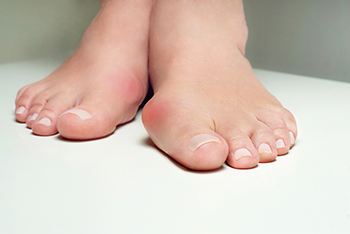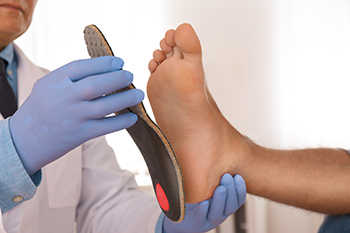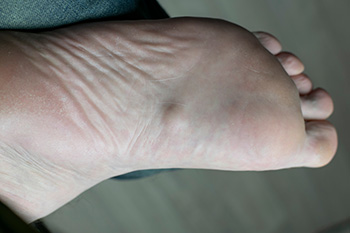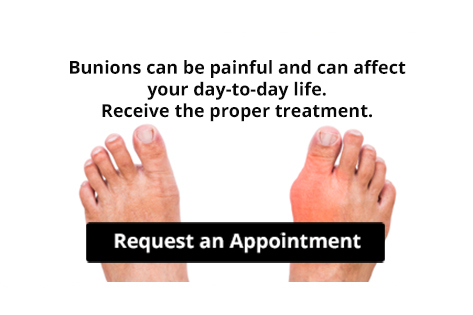Connect With Us
Blog
Items filtered by date: February 2025
Types of Gait Abnormalities

Gait abnormalities can place excessive strain on the feet, toes, and ankles, leading to pain and an increased risk of injury. Common gait abnormalities include propulsive gait, where a person leans forward while walking and spastic gait, which involves stiff, dragging movements. Steppage gait occurs when the foot drops, requiring exaggerated lifting of the leg. Waddling gait causes instability resulting from hip weakness, while ataxic gait results in unsteady, wide-based steps. Magnetic gait creates a sensation of the feet sticking to the ground, and antalgic gait shortens steps due to pain. These walking patterns may result from arthritis, nerve conditions, foot deformities, or injuries. A podiatrist can perform a gait analysis, which evaluates foot alignment, pressure distribution, and movement mechanics. This assessment helps identify the underlying cause of abnormal walking patterns and determines the best approach for relief. Treatment may include orthotic devices, footwear modifications, or even surgery. If you are experiencing foot pain while or after walking, it is suggested that you schedule an appointment with a podiatrist for a diagnosis and treatment options.
If you have any concerns about your feet, contact Soorena Sadri, DPM from FootWorx Active Podiatry. Our doctor can provide the care you need to keep you pain-free and on your feet.
Biomechanics in Podiatry
Podiatric biomechanics is a particular sector of specialty podiatry with licensed practitioners who are trained to diagnose and treat conditions affecting the foot, ankle and lower leg. Biomechanics deals with the forces that act against the body, causing an interference with the biological structures. It focuses on the movement of the ankle, the foot and the forces that interact with them.
A History of Biomechanics
- Biomechanics dates back to the BC era in Egypt where evidence of professional foot care has been recorded.
- In 1974, biomechanics gained a higher profile from the studies of Merton Root, who claimed that by changing or controlling the forces between the ankle and the foot, corrections or conditions could be implemented to gain strength and coordination in the area.
Modern technological improvements are based on past theories and therapeutic processes that provide a better understanding of podiatric concepts for biomechanics. Computers can provide accurate information about the forces and patterns of the feet and lower legs.
Understanding biomechanics of the feet can help improve and eliminate pain, stopping further stress to the foot.
If you have any questions please feel free to contact our office located in Fort Myers, FL . We offer the newest diagnostic and treatment technologies for all your foot and ankle needs.
Custom Orthotics Help Runners Protect Their Feet

Runners, meet your game-changer: Custom Orthotics. Every stride matters, and with Custom Orthotics, you can ensure optimal foot alignment, reducing stress on joints and muscles. They help absorb shock, protect against injuries, and can even enhance your running efficiency. Whether you're sprinting short distances or conquering marathons, Custom Orthotics provide the support and balance your feet crave. Call today for more information.
Causes and Risk Factors for Bunions

A bunion is a painful bony lump that forms at the base of the big toe when the top of the toe leans toward the second toe. Bunions often develop due to inherited foot structure, injuries, or excessive pressure on the front of the foot. People with flat feet or inward-rolling ankles may be more prone to the formation of bunions, as these conditions affect weight distribution and joint stability. Wearing tight, narrow, or high-heeled shoes can worsen the problem by increasing pressure on the big toe joint. Certain types of arthritis, like rheumatoid arthritis or gout, may also contribute by weakening the joint over time. As a bunion progresses, symptoms can include pain, redness, swelling, stiffness, and difficulty wearing shoes comfortably. Some people also develop corns, calluses, or ingrown toenails due to toe crowding. A podiatrist can evaluate the severity of a bunion and discuss treatment options, including footwear modifications or surgery if the condition significantly affects mobility. If you have foot problems related to bunions, it is suggested that you schedule an appointment with a podiatrist for a diagnosis and treatment options.
If you are suffering from bunions, contact Soorena Sadri, DPM of FootWorx Active Podiatry. Our doctor can provide the care you need to keep you pain-free and on your feet.
What Is a Bunion?
A bunion is formed of swollen tissue or an enlargement of boney growth, usually located at the base joint of the toe that connects to the foot. The swelling occurs due to the bones in the big toe shifting inward, which impacts the other toes of the foot. This causes the area around the base of the big toe to become inflamed and painful.
Why Do Bunions Form?
Genetics – Susceptibility to bunions are often hereditary
Stress on the feet – Poorly fitted and uncomfortable footwear that places stress on feet, such as heels, can worsen existing bunions
How Are Bunions Diagnosed?
Doctors often perform two tests – blood tests and x-rays – when trying to diagnose bunions, especially in the early stages of development. Blood tests help determine if the foot pain is being caused by something else, such as arthritis, while x-rays provide a clear picture of your bone structure to your doctor.
How Are Bunions Treated?
- Refrain from wearing heels or similar shoes that cause discomfort
- Select wider shoes that can provide more comfort and reduce pain
- Anti-inflammatory and pain management drugs
- Orthotics or foot inserts
- Surgery
If you have any questions, please feel free to contact our office located in Fort Myers, FL . We offer the newest diagnostic and treatment technologies for all your foot care needs.
Are Bunions Affecting Your Everyday Life?
Foot Orthotics for Treating Plantar Fasciitis

Plantar fasciitis is a common foot condition that causes pain in the heel and bottom of the foot, typically occurring after periods of rest or in the morning. It arises when the plantar fascia, a thick band of tissue that runs along the bottom of the foot, becomes irritated or inflamed due to overuse or abnormal foot mechanics. Symptoms often include sharp heel pain, especially with the first steps taken in the morning, and aching that worsens with activity. Foot orthotics are custom-designed shoe inserts that help treat plantar fasciitis by providing additional support to the arch and cushioning to the heel. These orthotics work to redistribute pressure across the foot, reducing strain on the plantar fascia and promoting proper alignment. By improving foot mechanics and alleviating stress on the heel, custom orthotics can significantly reduce pain, enhance comfort, and help prevent the recurrence of plantar fasciitis. If you have heel pain, it is suggested that you consult a podiatrist who can accurately diagnose plantar fasciitis, and offer treatment solutions that may include custom-made orthotics.
If you are experiencing discomfort in your feet and would like to try custom orthotics, contact Soorena Sadri, DPM from FootWorx Active Podiatry. Our doctor can provide the care you need to keep you pain-free and on your feet.
What Are Custom Orthotics?
Custom orthotics are inserts you can place into your shoes to help with a variety of foot problems such as flat feet or foot pain. Orthotics provide relief and comfort for minor foot and heel pain.
Over-the-Counter Inserts
Shoe inserts come in a wide variety and are used to treat foot pain, heel pain, and minor problems. For example, arch supports can be inserted into your shoes to help correct overarched or flat feet, while gel insoles are often used because they provide comfort and relief from foot and heel pain by alleviating pressure.
Prescription Orthotics
If over-the-counter inserts don’t work for you or if you have a more severe foot concern, it is possible to have your podiatrist prescribe custom orthotics. These high-quality, custom inserts are designed to treat problems such as abnormal motion, plantar fasciitis, and severe forms of heel pain. They can even be used to help patients suffering from diabetes by treating foot ulcers and painful calluses and are usually molded to your feet individually, which allows them to provide full support and comfort.
If you're experiencing minor to severe foot or heel pain, it’s recommended to speak with your podiatrist about the possibility of using custom orthotics or shoe inserts. A podiatrist can determine which type of custom orthotic or shoe insert is right for you and help you take the first steps toward being pain-free.
If you have any questions please contact our office located in Fort Myers, FL . We offer the newest diagnostic and treatment technologies for all your foot and ankle needs.
Causes of Cracked Heels in Children

Cracked heels in children can be an uncomfortable condition that may lead to pain and irritation. Several factors contribute to this issue, with dry skin being one of the primary causes. When the skin on the feet becomes too dry, it loses its elasticity, which can cause cracking, particularly around the heel area. In some cases, an underlying pathological phenomenon, such as eczema or psoriasis, may also contribute to cracked heels. These conditions can cause skin inflammation and dryness, increasing the likelihood of heel cracks. Additionally, footwear that does not provide adequate support can put pressure on the heels and cause them to become dry and cracked. Poor foot hygiene or standing for long periods of time can also worsen the condition. Maintaining good foot care, using moisturizers, and ensuring children wear well-fitting shoes can help prevent and treat cracked heels. If the condition persists, it is suggested that you consult a podiatrist who can effectively treat cracked heels, which may include prescribed medication.
If the skin on your feet starts to crack, you may want to see a podiatrist to find treatment. If you have any concerns, contact Soorena Sadri, DPM from FootWorx Active Podiatry. Our doctor can provide the care you need to keep you pain-free and on your feet.
Cracked Heels
It is important to moisturize your cracked heels in order to prevent pain, bleeding, and infection. The reason cracked heels form is because the skin on the foot is too dry to support the immense pressure placed on them. When the foot expands, the dry skin on the foot begins to split.
Ways to Help Heal Them
- Invest in a good foot cream
- Try Using Petroleum Jelly
- Ease up on Soaps
- Drink Plenty of Water
Ways to Prevent Cracked Heels
- Moisturize After Showering
- Skip a Shower
- Keep Shower Water Lukewarm
- Don’t Scrub Your Feet
If you are unsure how to proceed in treating cracked heels, seek guidance from a podiatrist. Your doctor will help you with any questions or information you may need.
If you have any questions, please feel free to contact our office located in Fort Myers, FL . We offer the newest diagnostic and treatment technologies for all your foot care needs.
Understanding Plantar Fibromatosis

Plantar fibromatosis is a condition where benign, firm nodules develop in the plantar fascia, the thick band of tissue along the bottom of the foot. These nodules are typically slow-growing and non-cancerous but can cause discomfort or pain, especially when walking or standing. The exact cause is unclear, but it may result from trauma, genetic predisposition, or abnormal tissue growth. Risk factors include a family history of fibromatosis, diabetes, liver disease, and certain medications. Although not life-threatening, plantar fibromatosis can interfere with daily activities and quality of life. A podiatrist can assess the severity of the condition and recommend treatments, such as orthotics, targeted exercises, injections, or, in severe cases, surgery. If you notice lumps in your foot, it is suggested that you promptly consult a podiatrist.
A plantar fibroma may disrupt your daily activities. If you have any concerns, contact Soorena Sadri, DPM of FootWorx Active Podiatry. Our doctor can provide the care you need to keep you pain-free and on your feet.
Plantar Fibroma
A plantar fibroma is a fibrous knot in the arch of the foot. It is embedded in the plantar fascia which is a band of tissue that extends from the heel to the toes along the bottom of the foot. There can be multiple plantar fibromas in the feet at the same time. There are no known causes for this condition. If you have a plantar fibroma, there will be a bump in the arch of your foot that cannot be missed. Any associated pain is most often due to a shoe rubbing against the nodule. Non-surgical options, such as steroid injections, physical therapy, and orthotics should be tried first. Surgery is a last resort and is the only thing that will remove a plantar fibroma entirely. Consult with a podiatrist for a proper diagnosis and to determine the treatment regimen that is right for you.
What Causes a Plantar Fibroma?
While there are no specific causes identified, a plantar fibroma can possibly come from genetic predisposition or the formation of scar tissue that forms from healing the tears in the plantar fascia.
What Are the Symptoms of a Plantar Fibroma?
There will be a noticeable lump in the arch of the foot that may or may not cause pain. If pain is felt, it is typically because a shoe is rubbing up against the lump or when walking or standing barefoot.
Treatment and Prevention
A plantar fibroma will not disappear without treatment, but it can get smaller and be a non-issue. If pain persists, a podiatrist examines the foot and when the arch of the foot is pressed, pain can be felt down to the toes. An MRI or biopsy might be performed to help diagnose or evaluate the plantar fibroma. The following non-surgical options are generally enough to reduce the size and pain of these nodules:
- Steroid injections
- Orthotics
- Physical therapy to help apply anti-inflammatory creams on the bump
Surgery is considered if the mass increases in size and the patient continues to feel pain after non-surgical methods are tried.
If you have any questions please feel free to contact our office located in Fort Myers, FL . We offer the newest diagnostic tools and technology to treat your foot and ankle needs.
Blog Archives
- April 2025
- March 2025
- February 2025
- January 2025
- December 2024
- November 2024
- October 2024
- September 2024
- August 2024
- July 2024
- June 2024
- May 2024
- April 2024
- March 2024
- February 2024
- January 2024
- December 2023
- November 2023
- October 2023
- September 2023
- August 2023
- July 2023
- June 2023
- May 2023
- April 2023
- March 2023
- February 2023
- January 2023
- December 2022
- November 2022
- October 2022
- September 2022
- August 2022
- July 2022

